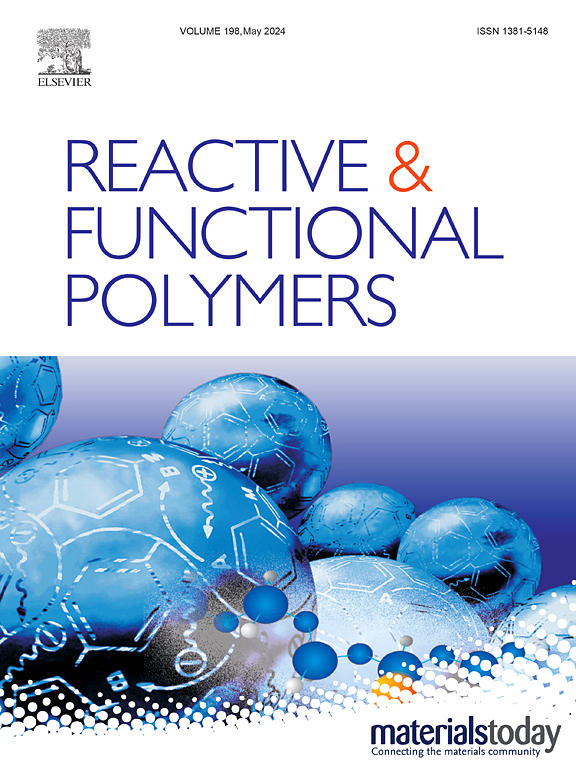Synthesis, characterization, and pharmaceutical activities of new metallated ionic chitosan Schiff base hydrogels as potential chemotherapeutic agents
IF 4.5
3区 工程技术
Q1 CHEMISTRY, APPLIED
引用次数: 0
Abstract
Facile and green protocols were used to synthesize a novel series of metallated ionic chitosan Schiff base hydrogels (ICSBHs) by grafting low-molecular-weight chitosan (LMC) with salicylaldehyde-imidazolium/thiazolium ionic liquids (Me2ImSal+MClx− and MeThSal+MClx−, 2a-f) (M = Ti, x = 6; M = Pd and x = 4). Physical characterization of the new hydrogels was performed based on solubility, sol-gel fractions, and solvent uptake measurements. Meanwhile, these hydrogels were structurally and morphologically characterized using microanalytical and spectral analyses (FTIR, NMR (1H NMR, 13C NMR, and 1H![]() 15N HMBC NMR), EDX, ESI-MS, and SEM). Interestingly, PdCl4 ion performs better than TiCl6 as a crosslinking agent for cationic chitosan Schiff base, as revealed from the higher crosslinking levels and, consequently, porosity of PdCl4-based hydrogels compared to TiCl6-based hydrogels. Interestingly, the PdCl4-based hydrogel (ICSBH6) exhibited significant antimicrobial potential, outperforming the clinical drug ciprofloxacin (CIP) (MIC/MBC values of ICSBH6 were 15.85 /31.7, while the values were 33.4/66.8 for CIP, against S. aureus). Meanwhile, ICSBH6 showed superior antibiofilm and anticancer potentials. The MTT assay findings revealed ICSBH6 as a promising and safe anti-hepatocarcinoma chemotherapeutic agent with a significantly low IC50 value of 3.79 μg/mL against Huh-7 cancer cells, while a high IC50 value (48.87 μg/mL) against normal BNL cells. According to the results of in silico studies, ICSBH6 exhibits higher binding affinities for bacterial biofilm formation and antibiotic resistance-induction proteins (6M3A/ 7C7R) (−11.1/−11.77 kcal/mol) than CIP.
15N HMBC NMR), EDX, ESI-MS, and SEM). Interestingly, PdCl4 ion performs better than TiCl6 as a crosslinking agent for cationic chitosan Schiff base, as revealed from the higher crosslinking levels and, consequently, porosity of PdCl4-based hydrogels compared to TiCl6-based hydrogels. Interestingly, the PdCl4-based hydrogel (ICSBH6) exhibited significant antimicrobial potential, outperforming the clinical drug ciprofloxacin (CIP) (MIC/MBC values of ICSBH6 were 15.85 /31.7, while the values were 33.4/66.8 for CIP, against S. aureus). Meanwhile, ICSBH6 showed superior antibiofilm and anticancer potentials. The MTT assay findings revealed ICSBH6 as a promising and safe anti-hepatocarcinoma chemotherapeutic agent with a significantly low IC50 value of 3.79 μg/mL against Huh-7 cancer cells, while a high IC50 value (48.87 μg/mL) against normal BNL cells. According to the results of in silico studies, ICSBH6 exhibits higher binding affinities for bacterial biofilm formation and antibiotic resistance-induction proteins (6M3A/ 7C7R) (−11.1/−11.77 kcal/mol) than CIP.

作为潜在化疗药物的新型金属离子壳聚糖席夫碱水凝胶的合成、表征和药物活性
以低分子量壳聚糖(LMC)与水杨醛-咪唑/噻唑离子液体(Me2ImSal+MClx -和MeThSal+MClx -, 2a-f) (M = Ti, x = 6)接枝,制备了一系列新型金属化离子壳聚糖希夫碱水凝胶(ICSBHs)。M = Pd和x = 4)。根据溶解度、溶胶-凝胶组分和溶剂吸收率测量,对新水凝胶进行了物理表征。同时,利用FTIR、NMR (1H NMR、13C NMR和1H15N HMBC NMR)、EDX、ESI-MS和SEM等微量分析和光谱分析对水凝胶进行了结构和形态表征。有趣的是,作为阳离子壳聚糖希夫碱的交联剂,PdCl4离子比TiCl6表现得更好,这从更高的交联水平和PdCl4基水凝胶的孔隙率来看,与TiCl6基水凝胶相比。有趣的是,基于pdcl4的水凝胶(icshbh6)表现出显著的抗菌潜力,优于临床药物环丙沙星(CIP) (icshbh6的MIC/MBC值为15.85 /31.7,而CIP的MIC/MBC值为33.4/66.8)。同时,icshbh6显示出良好的抗菌膜和抗癌潜力。MTT实验结果显示,icshbh6对Huh-7癌细胞的IC50值为3.79 μg/mL,对正常BNL细胞的IC50值为48.87 μg/mL,是一种有前景的安全的抗肝癌化疗药物。实验结果表明,icshbh6对细菌生物膜形成和抗生素耐药诱导蛋白(6M3A/ 7C7R)的结合亲和力(- 11.1/ - 11.77 kcal/mol)高于CIP。
本文章由计算机程序翻译,如有差异,请以英文原文为准。
求助全文
约1分钟内获得全文
求助全文
来源期刊

Reactive & Functional Polymers
工程技术-高分子科学
CiteScore
8.90
自引率
5.90%
发文量
259
审稿时长
27 days
期刊介绍:
Reactive & Functional Polymers provides a forum to disseminate original ideas, concepts and developments in the science and technology of polymers with functional groups, which impart specific chemical reactivity or physical, chemical, structural, biological, and pharmacological functionality. The scope covers organic polymers, acting for instance as reagents, catalysts, templates, ion-exchangers, selective sorbents, chelating or antimicrobial agents, drug carriers, sensors, membranes, and hydrogels. This also includes reactive cross-linkable prepolymers and high-performance thermosetting polymers, natural or degradable polymers, conducting polymers, and porous polymers.
Original research articles must contain thorough molecular and material characterization data on synthesis of the above polymers in combination with their applications. Applications include but are not limited to catalysis, water or effluent treatment, separations and recovery, electronics and information storage, energy conversion, encapsulation, or adhesion.
 求助内容:
求助内容: 应助结果提醒方式:
应助结果提醒方式:


